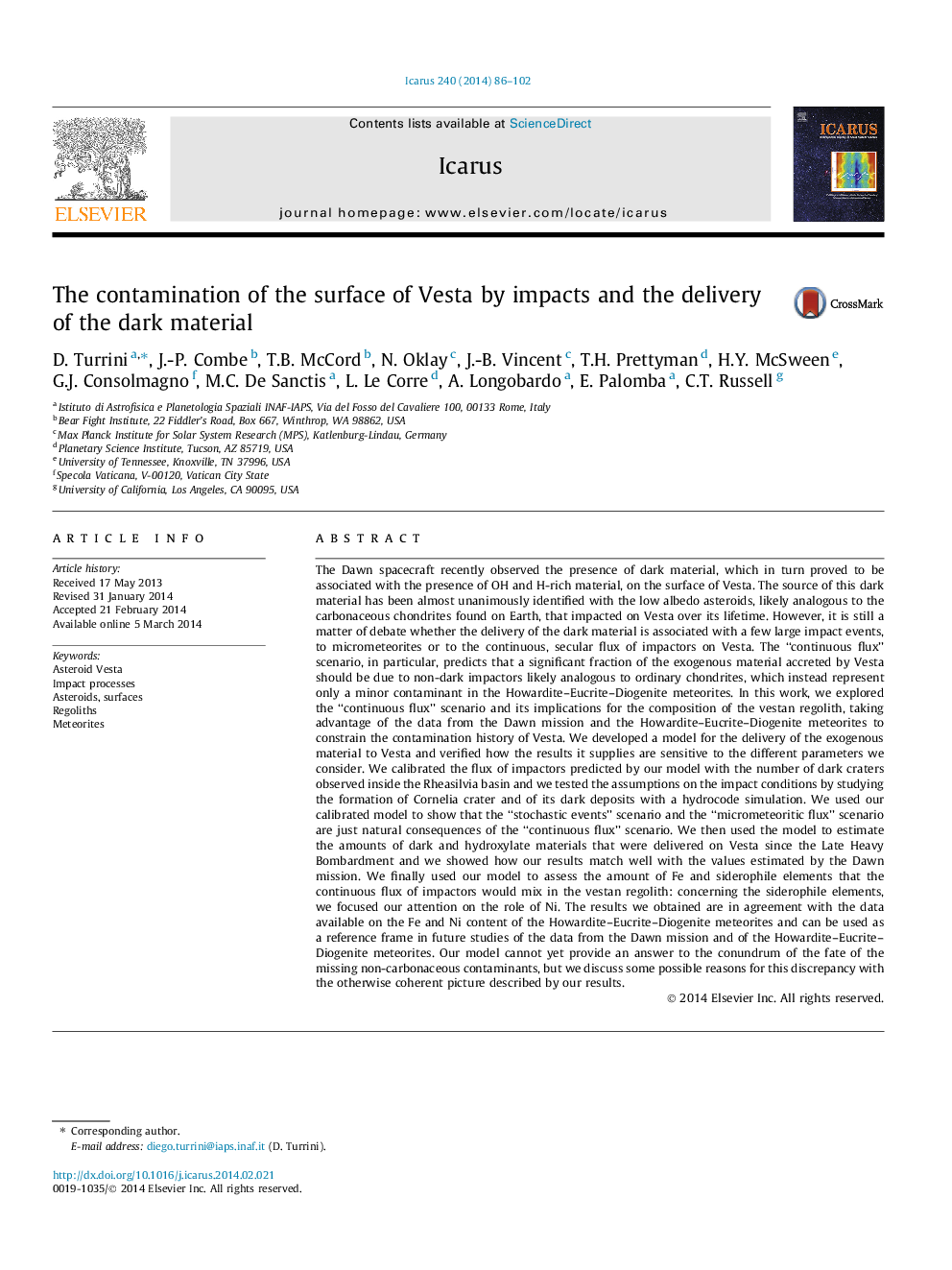| کد مقاله | کد نشریه | سال انتشار | مقاله انگلیسی | نسخه تمام متن |
|---|---|---|---|---|
| 1773068 | 1523550 | 2014 | 17 صفحه PDF | دانلود رایگان |
عنوان انگلیسی مقاله ISI
The contamination of the surface of Vesta by impacts and the delivery of the dark material
ترجمه فارسی عنوان
آلودگی سطح وستا به وسیله اثرات و تحویل مواد تاریک
دانلود مقاله + سفارش ترجمه
دانلود مقاله ISI انگلیسی
رایگان برای ایرانیان
کلمات کلیدی
موضوعات مرتبط
مهندسی و علوم پایه
علوم زمین و سیارات
علوم فضا و نجوم
چکیده انگلیسی
The Dawn spacecraft recently observed the presence of dark material, which in turn proved to be associated with the presence of OH and H-rich material, on the surface of Vesta. The source of this dark material has been almost unanimously identified with the low albedo asteroids, likely analogous to the carbonaceous chondrites found on Earth, that impacted on Vesta over its lifetime. However, it is still a matter of debate whether the delivery of the dark material is associated with a few large impact events, to micrometeorites or to the continuous, secular flux of impactors on Vesta. The “continuous flux” scenario, in particular, predicts that a significant fraction of the exogenous material accreted by Vesta should be due to non-dark impactors likely analogous to ordinary chondrites, which instead represent only a minor contaminant in the Howardite-Eucrite-Diogenite meteorites. In this work, we explored the “continuous flux” scenario and its implications for the composition of the vestan regolith, taking advantage of the data from the Dawn mission and the Howardite-Eucrite-Diogenite meteorites to constrain the contamination history of Vesta. We developed a model for the delivery of the exogenous material to Vesta and verified how the results it supplies are sensitive to the different parameters we consider. We calibrated the flux of impactors predicted by our model with the number of dark craters observed inside the Rheasilvia basin and we tested the assumptions on the impact conditions by studying the formation of Cornelia crater and of its dark deposits with a hydrocode simulation. We used our calibrated model to show that the “stochastic events” scenario and the “micrometeoritic flux” scenario are just natural consequences of the “continuous flux” scenario. We then used the model to estimate the amounts of dark and hydroxylate materials that were delivered on Vesta since the Late Heavy Bombardment and we showed how our results match well with the values estimated by the Dawn mission. We finally used our model to assess the amount of Fe and siderophile elements that the continuous flux of impactors would mix in the vestan regolith: concerning the siderophile elements, we focused our attention on the role of Ni. The results we obtained are in agreement with the data available on the Fe and Ni content of the Howardite-Eucrite-Diogenite meteorites and can be used as a reference frame in future studies of the data from the Dawn mission and of the Howardite-Eucrite-Diogenite meteorites. Our model cannot yet provide an answer to the conundrum of the fate of the missing non-carbonaceous contaminants, but we discuss some possible reasons for this discrepancy with the otherwise coherent picture described by our results.
ناشر
Database: Elsevier - ScienceDirect (ساینس دایرکت)
Journal: Icarus - Volume 240, 15 September 2014, Pages 86-102
Journal: Icarus - Volume 240, 15 September 2014, Pages 86-102
نویسندگان
D. Turrini, J.-P. Combe, T.B. McCord, N. Oklay, J.-B. Vincent, T.H. Prettyman, H.Y. McSween, G.J. Consolmagno, M.C. De Sanctis, L. Le Corre, A. Longobardo, E. Palomba, C.T. Russell,
